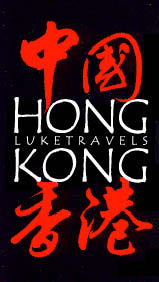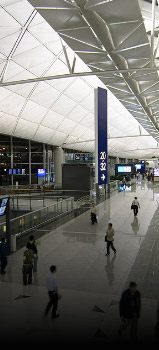| |
Hong Kong: HKG Airport
ICAO:
VHHH | IATA: HKG
Hong
Kong International Airport Chek Lap Kok
The new Chek Lap Kok
香港國際機場 airport sprawls over an entire island well removed from the city. If your hotel will not give you a lift, to get from the airport to your final destination, and back again, you can travel by Airport Express train, public bus, or taxi. The Airport Express trains run daily from 6 AM to 1 AM. A one-way ticket costs HK$90 to or from Kowloon,
or HK$100 to or from Hong Kong station. Bus fare is about half as
much as train fare and a cab ride can cost three times as much.
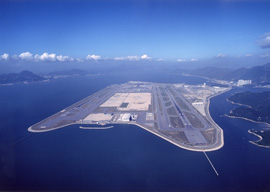 |
|
 |
|
[Photo
©
Hong Kong Airport Authority] |
|
[Photo
©
Hong Kong Airport Authority] |
Hong Kong's Chek Lap Kok
is serviced by over a hundred international carriers.
Travelers from North America have many choices: Northwest Airlines
offers flights from all major U.S. cities via its Tokyo Narita hub. United Airlines
offers non-stop flights to Chek Lap Kok from my hometown, Chicago. I
took this flight back in 1998, and I believe this was the longest
flight I have ever been on -- 16 hours-long! United also
offers non-stop flights to Hong Kong from San Francisco, Los Angeles and Tokyo
Narita. There are also numerous Asian air carriers who serve Hong
Kong from many US cities. If you would like to find a low
fare to Hong Kong, click here and create your
itinerary.
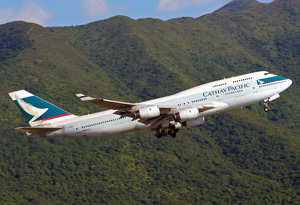 |
 |
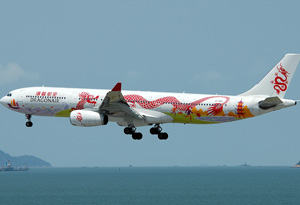 |
| |
|
|
Cathay
Pacifc B747-400 |
國泰航空有限公司
Cathay makes Hong Kong its main hub. The airline was founded
in 1946. It operates a modern fleet of 101 aircraft with 102
destinations world-wide. Named best airline in 2003 and 2005.
Airline of the year in 2006. [Photo
© K.
Ho] |
|
Dragonair
A330-300 |
港龍航空有限公司
Dragonair is Hong Kong's second largest carrier. It was
founded in 1985. Dragonair operates a fleet of 33 mostly
wide-body aircraft. [Photo
© M.
Tang] |
| |
|
|
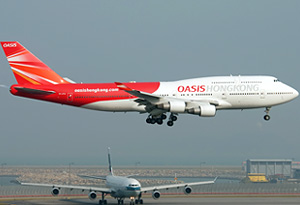 |
|
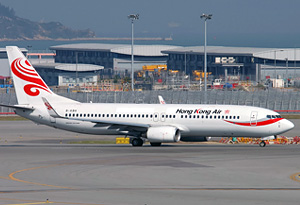 |
| |
|
|
Oasis Hong
Kong Airlines B747-400
甘泉香港航空有限公司
Newest
addition to the Hong Kong Airport. Founded in October of 2006
with its inaugural flight to London UK. Oasis currently has
two Boeing 747 aircraft in use. [Photo
© K.
L. Yim] |
|
Hong Kong
Airlines Limited B737-800
香港航空有限公司
Founded in
2001. Operates flights between Hong Kong airport and mainland
China. Future routes will include flights to Japan and Korea.
[Photo ©
K. L. Yim] |
| |
|
|
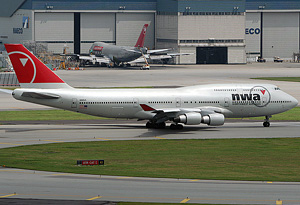 |
|
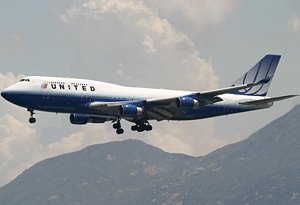 |
| |
|
|
Northwest
Airlines B747-400
Daily flights from USA on Delta Air Lines via Toyko Narita Japan. [Photo
© C.
Y. Li] |
|
United
Airlines B747-400
United offers non-stop flights to Hong Kong from Tokyo, San
Francisco, Los Angeles and Chicago. United offered a non-stop
New York City - Hong Kong flight back in 2001. [Photo
© S.
Lam] |
| |
|
|
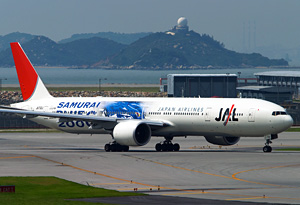 |
|
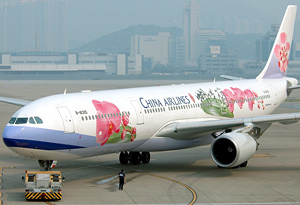 |
| |
|
|
Japan
Airlines B777-300
日本航空インターナショナル
JAL offers many frequencies between Hong
Kong and Japan.
[Photo
©
K. H. Ng] |
|
China
Airlines A330-200 | 中華航空公司
Based in
Taipei, Taiwan with focus cities in Hong Kong, Kaohsiung and
Bangkok. [Photo ©
M. Tang] |
I have visited
many amazing airports around the world, however, Hong Kong's Chek
Lap Kok is by far the most spectacular human engineered
wonder. It's size alone, takes your breath away. Be sure
to follow signs closely, or better yet, follow the crowds, or else
you'll get lost in the maze of elevators, escalators, numerous
levels, and underground trams. No expense has been spared in ensuring that visitors to Hong Kong can get from the new airport at Chek Lap Kok to their final destination quickly and efficiently, regardless of where they are staying in the territory. To satisfy this demand required one of the world's most ambitious infrastructure
programs - a HK$ 155.3 billion engineering project that included new rail lines, bridges and highways. Composed of
ten projects, each a major construction and engineering effort in itself, this Airport Core
Program (ACP) features, among other marvels, the new Tsing Ma Bridge, 30
kilometers of new highway, the high-speed Airport Express (AEL) railway and the airport itself.
 Chek
Lap Kok Statistics (2005)
Chek
Lap Kok Statistics (2005)
- Number
of Passengers 40,053,819
- Number
of Takeoffs/Landing 210,112
-
Capacity: Passenger (current) 45,000,000 / Passenger (ultimate)
87,000,000
- Cargo
(current) 3m tons / Cargo (ultimate) 9m tons
- Apron
(current) 96
- Number
of destinations: International (air) 130 / International (water) 6
 Chek
Lap Kok Facts and Figures
Chek
Lap Kok Facts and Figures
- length
1.27 kilometers from entrance to end of Y-shaped concourse
- total
area 570,000 sq m, about nine times the size of the old Kai Tak
terminal
-
passenger level changes Arrivals, none. Departures, one.
-
passenger facilities Check-in desks: 288
-
immigration counters: 88 (departure) / 118 (arrival)
- baggage
reclaim units: 12 - first bag from aircraft to reclaim unit, about
20 minutes
-
Automated People Mover Internal shuttle train between East Hall
and West Hall with frequency less than 3 minutes
- moving
walkways 74 (Arrivals: 30, Departures: 34, Ground Transportation
Centre: 10)
- luggage
trolleys 9,900 (Landside and Airside)
- seats
15,000 (1,200 in landside)
-
elevators/lifts 98
-
escalators 70
-
commercial area 200 outlets, including 40 food and beverage
outlets in 39,000 sq m shopping mall environment
- car
parking multi-story and ground level, about 2,400 spaces
- public
transport Taxi loading ranks, 24 bays for 550 vehicles
- tour
coaches, 18 pick-up bays
- public
buses, 17 pick-up bays
- airport
mainland coach, 10 pick-up bays
- Airport
Express Line Trains leaving every 12 minutes. A 23-minute journey
from Airport Station to Hong Kong Station.
- official
name: Hong Kong International Airport
- airport
opening: July 1998
- total
airport site area: 1,255 hectares
-
passenger throughput in 2005: 40.74 million
- air
cargo throughput in 2005: 3.4 million tons
- flight
handling capacity: 53 flights per hour at peak hours
- runways:
two at 12,300 feet long 3,800 meters
- Aircraft
Parking Bays Frontal 49, Apron 28, Air cargo 25
- airport
workforce About 55,000
-
operation 24 hours, all year
- Hotel
Adjacent to passenger terminal 1,100 rooms
 In town Check-in (ITCI) Services In town Check-in (ITCI) Services
For enhanced convenience, check-in counters for all air-lines are located at both the Hong Kong and Kowloon stations of the Airport Express. Service is complimentary for AEL passengers.
 Automated People Mover (APM) Automated People Mover (APM)
This driverless shuttle train runs along the Passenger Terminal concourse providing easy access to distant aircraft gates. Each APM train can carry up to 200 passengers. There are two stations and the journey takes approximately 90 seconds.
 Coach Terminal Coach Terminal
The transportation Centre's coach terminal contains 18 pick-up bays and 52 bays for tour coaches.
 Facilities for the Physically Challenged Facilities for the Physically Challenged
The terminal has been designed to accommodate those with mobility and sensory disabilities. Free porter service and directional assistance is available Requests for assistance can be made to airport staff, at Information Counters or through Help Phones, Ramps and escalators facilitate changes of level within the terminal and lifts with audible indicators are available at all key areas as alternatives to escalators. Electric carts for use within the terminal can be obtained by contacting airlines or their handling agents.
Check-in counters and immigration and customs zones have special needs facilities designed to aid passengers with disabilities. Public facilities such as toilets,
e-phones also incorporate special features for disabled users. For the visually impaired, a tactile guide path has been installed on the
departures curb and from the Airport Express platform through to Information Counters and selected Help Phones.
 Flight Information Display Boards Flight Information Display Boards
Over 2,000 display boards and monitors in both English and Chinese are situated in strategic locations at both the Arrivals and Departures Levels to provide up-to-the-minute information on flight arrivals and departures. Flight information is also available from passenger information kiosks throughout the building.
 Immigration Immigration
Operated by Hong Kong's Immigration Department, there are 128 immigration desks for arriving passengers and 96 for departing passengers. All visiting passengers are asked to check their visa requirements before
traveling to Hong Kong. For inquiries, use the airport Help Phones.
 Hong Kong Sky Mall Hong Kong Sky Mall
With 141 outlets offering a range of quality retailing at downtown prices, Hong Kong Sky Mall is one of the most exciting airport shopping malls in the world. A true mega-complex, Sky Mall offers 25 food and beverage outlets as well as shops in a 30,000-square
meter, five-zone shopping environment.
 Rail Link Rail Link
Operated by the Mass Transit Railway Corporation (MTRC), the high-speed Airport Express (AEL) rail
service takes passengers from Hong Kong Station in the Central business district to the airport, with two stops en route, in just 23 minutes. From the first stop, Kowloon Station, travel time to the airport is only 19 minutes. Travel time to the airport the second stop, Tsing Yi Station, is 12 minutes. One-way adult fare to/from the airport is HK$100 Hong Kong Island; HK$90 for Kowloon. Children's fare is approximately half. Free shuttle bus transfers to hotels is available for AEL users.
 Taxis Taxis
Taxis to almost anywhere in Hong Kong are readily available. The taxi staging area can
accommodate 530 vehicles. Red taxis serve Hong Kong Island and Kowloon, green taxis serve the new Territories and blue taxis serve Lantus Island.
Since taxi routes and distances are subject to change, the following fares are estimates only :
 Ferry Links Ferry Links
Ferry services operate between the airport and Tuen Mun in the New territories. These services will be expanded to other urban
centers in time. Ferry services operate from 6 am to 10 pm daily at 20-to 30-minute intervals. The one-way fare is HK$15 (adults), HK$10 (children). Each trip takes about 15 minutes.
 Hotel and Travel Agent Transfer Hotel and Travel Agent Transfer
Visitors who have booked rooms in certain hotel and have arranged transport with the hotel can find hotel shuttle buses, limousines and cars in the central area of the airport's Transportation Centre. The southern end of the Transportation Centre is where tour buses are parked for visitors who have booked tours that begin from the arrival point at the airport.
 Bus Service Bus Service
There are 28 franchised bus routes serving the airport. Twenty-two are conventional lines primarily of use to local residents with numerous stops. Six are airbuses, primarily dedicated to departing and arriving airline passengers. They have fewer stops and stop at some hotels.



|
|
